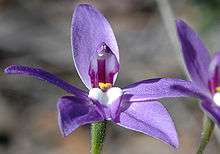Glossodia major
| Waxlip Orchid | |
|---|---|
 | |
| Southern Mid-lands of Tasmania | |
| Scientific classification | |
| Kingdom: | Plantae |
| (unranked): | Angiosperms |
| (unranked): | Monocots |
| Order: | Asparagales |
| Family: | Orchidaceae |
| Subfamily: | Orchidoideae |
| Tribe: | Diurideae |
| Subtribe: | Caladeniinae |
| Genus: | Glossodia |
| Species: | G. major |
| Binomial name | |
| Glossodia major R.Br. | |
Glossodia major, commonly known as the Waxlip Orchid is a small terrestrial orchid, found in eastern Australia. This plant first appeared in scientific literature in 1810, in the Prodromus Florae Novae Hollandiae authored by the prolific Scottish botanist, Robert Brown.[1]
Reaching 12–32 cm (4.5–12.5 in) in height, Glossodia major consists of a single herbaceous stem and lanceolate leaf which measures 4 to 15 cm (1.5 to 6 in) long. One or two flowers appear from August to October. Measuring up to 6 cm (2.5 in) across, they are predominantly purple but occasionally white. The labellum is white at the base.[2]
Glossodia major can be distinguished from the small waxlip orchid (Glossodia minor) by its larger flowers. The latter species lacks the white base to the labellum.[3]
Glossodia minor is found in the eastern Australia in Queensland and across central and eastern New South Wales, where it reaches as far west as Ardlethan district.[2]
References
- ↑ "Glossodia major R.Br.". Australian Plant Name Index (APNI), IBIS database. Centre for Plant Biodiversity Research, Australian Government.
- 1 2 P. Bernhardt. "New South Wales Flora Online: Glossodia major". Royal Botanic Gardens & Domain Trust, Sydney, Australia.
- ↑ Bishop, Anthony (2000). Field guide to the orchids of New South Wales and Victoria. UNSW Press. p. 163. ISBN 0-86840-706-2.
External links
| Wikimedia Commons has media related to Glossodia major. |
| Wikispecies has information related to: Glossodia major |